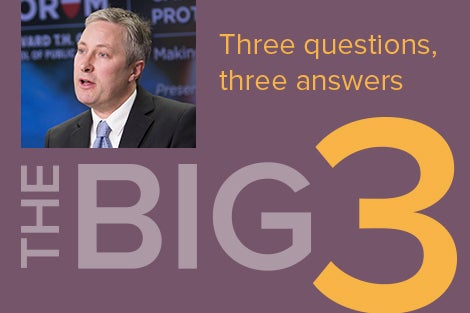May 9, 2016 — E-cigarettes, cigars, pipe tobacco, and hookah tobacco will soon be regulated by the U.S. Food and Drug Administration (FDA), and their sale will be banned to anyone under age 18, it was announced May 5. Vaughan Rees, director of the Center for Global Tobacco Control at Harvard Chan School, discusses the impact of this new policy on public health.
Describe the importance of this new FDA regulation and what effect it might have on tobacco use among young people.
Finally the FDA has taken action, so it is a welcome start. The new regulations will require companies to submit e-cigarettes and other newer tobacco products for government approval, to provide ingredient lists, and to include health warnings on packages and in ads. In addition, sales of these products will be banned to anyone under 18. The public health community and the tobacco control community are grateful for the fact that e-cigarettes will now be regulated as tobacco products.
But the FDA did not take decisive steps in implementing strategies that will really address concerns about youth initiation to e-cigarettes—notably, they did not eliminate candy and exotic flavors in e-cigarettes. This is a big problem because, in recent years, there has been a dramatic increase in the prevalence of e-cigarette use among youth.
The FDA’s stated argument is that they wanted to keep flavors because they think it could be important to encourage adults to switch to e-cigarettes. But that is a weak argument. Adults are not attracted to flavors such as bubble gum or other candy flavors—those are obviously intended to appeal to youth. My contention is that the FDA could have helped to prevent youth initiation through the elimination of candy and exotic flavors while preserving a limited range of taste or sensory characteristics that might appeal to adult smokers.
What else might the FDA have done differently?
They have not eliminated broad-based advertising. E-cigarette manufacturers are still free to use TV, radio, billboards—means that are not generally available to manufacturers of cigarettes. That’s also disappointing.
Also, the FDA has not taken this opportunity to implement product standards for e-cigarettes. They could have set standards to reduce the potential toxicity of e-cigarettes—essentially forcing manufacturers to clean them up. They also could have ensured that e-cigarettes provide a viable alternative to conventional cigarettes. E-cigarettes often don’t deliver as much nicotine as a conventional cigarette, so it makes it hard for a smoker to switch completely to e-cigarettes if they are trying to quit. So the FDA could have required e-cigarettes be both safer and more viable as a satisfying alternative for current smokers, but they chose not to at this time.
Why do you think the FDA didn’t go farther with these regulations?
They’re concerned about litigation from manufacturers and they don’t have the science base they need to defend aggressive litigation against far-reaching regulations. I think that getting rid of candy flavorings and setting stricter product standards are rational and plausible ideas, but a firmer evidence base may be needed. The FDA might issue more effective regulations in the future, but they seem to not be ready to do that yet.
Overall, the new regulations are a mixed bag. We’re on the road to some form of regulatory protection, but we still have a long way to go in terms of devising long-term strategies for e-cigarettes—particularly those that would protect young people from nicotine addiction.
